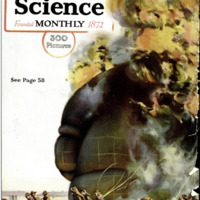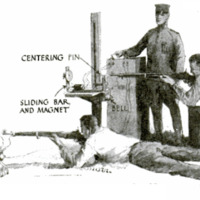-
Title (Dublin Core)
-
Instead of announcing a bull's eye, a new device says when the recruit has made some mistakes in shooting training
-
Article Title and/or Image Caption (Dublin Core)
-
Title: If the Bell RIngs You're a Bad Shot
-
Subtitle: Instead of announcing a bull's eye, the ting-a-ling says you're a trigger-jerker
-
extracted text (Extract Text)
-
ABOUT ninety-five per cent of
successful rifle or pistol shooting
lies in the smooth release of the
striking mechanism of the arm that
fires the cartridge. Trigger “squeeze”
instead of jerk is the hardest thing to
teach a beginner, and it is the first
thing he forgets when he shoots hur-
riedly or under excitement. He is
not alone in this; for the veteran shot
gets spells of fudging or flinching, and
they usually go band in hand with
convulsive pulls of the trigger.
The Novice's Dread of Noise
“The novice jerks the trigger,
displacing hia im and. sending
his shot wild, usually becuse
he's afraid of the noise and
the Lek of the gun, and
also because he tries to
make the shot go when
the sights are just right,
and, in the parlance of
the rife shot, he “quits
holding and’ pulls the
trigger.” The experi-
enced shot can make his
shot £0 when the sights
“ouch the spot, but the recruit. has to
arrive at this stage by way of the
radual trigger saueese
Trigger-jerking is one of the most
dificult tricks the instructor has to
overcome. At the Smal Arms Firing
School of the Army, at Camp Perry,
Ohio, the pistol nsiructors feel that,
When they've got the student officer
pas this Jerking period, he lacks only
practice to make a good pistol shot.
Except by the wild shooting of the
learner, the trick I ard to. detect,
If the un is empty, he doesn, 18 4
rule jerk the trigger. 1 it Is loaded,
the recoil usually covers up the move.
ment produced by his yanking habit.
Veteran instructors “get the goods on
Bim by the old trick af making him
think he's pulling the trigger of 4 load
ed gun’ when It is really empty, and
Doting. whether the arm moved as
the striker fell. This exposes without
curing the trouble.
To Cure the Trigger-Jerker
The best way to eure i i to “catch
‘em young," and to train them so
carefully in the preliminary practice
With empty rifle and with small:
caliber gallery rifle that ‘the careful
rigger squeeze it accomplished with-
out though,
“The most valuable accessory vet
invented for detecting and. demon:
strating to the shooter himself bad
trigger squeeze, is the Coleman aiming
device, which infallibly and violently
rings an electric bell when the shooter
jerks the trigger instead of squeezing
it. It is in use by the United States
Army, having been adopted by ‘the
General Staff.
It consists, primarily, of a slidable
frame carrying a steel peg a trifle
smaller than the interior of the bore
of therifle. The steel peg is connected
with one pole of a dry battery; the
other pole is connected by a temporary
wire with the barrel of the rifle.
The shooter takes aim at a minia-
ture target mounted on the apparatus
—a target reduced to the proportion
of the outdoor target at some given
and common range; then, when he has
steadied his aim, the instructor moves
the frame carrying the steel pin or peg
until it slips into the muzzle of the
rifle. It is a trifle smaller all round,
and as long as the rifle is held steadily
it does not touch the bore. With the
steel pin protruding into the bore, and
the rifle held steadily as the rifleman
aims, the instructor closes the electric
circuit, save for the gap between the
steel pin—one side of the eircuit—
and the barrel, the other side. The
least jerk of the rifle muzzle will move
the bore against the steel pin, close
the circuit, and ring an electric bell
that is part of the apparatus. Then,
with all this cooked up for the benefit
of the learner, he is told to aim care-
fully and squeeze the trigger as if
firing an actual shot at the target.
Ringing the Bell with New Meaning
If he has mastered the trigger
squeeze, and lets off as he must to do
accurate shooting on a real range, the
muzzle does not move, the circuit is
not closed, and the bell does not ring.
If, however, he jerks the trigger or
moves the rifle the least bit in let-
ting off, the bell buzzes merrily,
and bystanders hand him the
merry ha-ha. There is no alibi
-no bad cartridge to blame,
no puff of wind, no cant, no
mirage. He didn’t get off
with a smooth trigger
squeeze, and the bell
told the tale—told the
same tale the target-
marker would havetold,
| without allowing the
various excuses usually
dug up for bad shots
when in actual range
practice.
After a séance of preliminary train-
ing with this device, with its “bawl-
ing-out” bell to tell to all men the tale
of the trigger-jerker, the recruit either
learns. proper trigger squeeze beyond
all chance of forgetting it, or e'se
he's without the pale of possibilities
as a rifle shot.
The relation between the steel pin
and the bore depends on the skill of
the firer. Tle inexperienced marks-
man couldn't even hold steadily
enough to avoid closing the contact
with a pin as near the size of the
bore as that which the crack shot
could use without trouble; but, once
he’s learned how to hold steadily, the
pin can be so large as nearly to
touch the bore, and still never
close the circuit when the trigger is
let off.
The device, the invention of a
colonel in the army who understands
the difficulties of rifle training, is cheap
to make up and simple to operate,
the total accessories necessary for the
production of rough but serviceable
copies being merely a dry battery, a
bell, a little wire, a nail of the right
size, a piece of 1x12-inch pine board.
Add a simple switch for closing the
circuit when the aim has steadied
down, and you are all ready to begin
the test.
-
Contributor (Dublin Core)
-
Edward G. Croosman (Article writer)
-
Language (Dublin Core)
-
eng
-
Date Issued (Dublin Core)
-
1919-03
-
pages (Bibliographic Ontology)
-
42
-
Rights (Dublin Core)
-
Public domain (Google digitized)
-
Archived by (Dublin Core)
-
Davide Donà
-
Marco Bortolami (editor)
 Popular Science Monthly, v. 94, n. 3, 1919
Popular Science Monthly, v. 94, n. 3, 1919




